Unboxing & First Look: MSI MPG B850 EDGE Ti WIFI (AM5)
- Prologue: Between Anticipation and a Paper Knife
- Contents & Packaging: Layers, Compartments, Protective Foil
- Design & Build Quality: White, Angular, Cool
- Socket, Memory & Slots: The Stage for Ryzen
- M.2 & SATA: Four NVMe Slots and Legacy Support
- VRM & Cooling: Headroom for Big Ryzen
- Networking & Audio: Speed by Air and Wire
- Rear I/O: Well-Laid and Modern
- Internal Headers & QoL Features: The Small Things That Matter
- Board Backside: Clean & Practical
- Accessories in Detail: More Than Fillers
- First Assembly & Power-On: From Foil to Chassis
- B850 in Context: The New Mainstream
- Target Groups & Use Cases
- Hands-On Notes
- Critical Notes (From an Unboxing POV)
- In-System Impressions: Smooth Build Flow
- Mini Interim Conclusion (No Final Verdict Yet)
Prologue: Between Anticipation and a Paper Knife
There are those kinds of parcels you hold tightly in your hands at the doorstep, as if they contained the key to a new world. Today, such a package arrived: the MSI MPG B850 EDGE Ti WIFI – an AM5 motherboard that already flaunts buzzwords like “Ready for Ryzen 9000”, “Wi-Fi 7”, and “PCIe 5.0” on the front of the box. It feels like the present, but with a lean toward the future. “Any sufficiently advanced technology is indistinguishable from magic,” wrote Arthur C. Clarke – and somewhere between anti-static foil and brushed aluminum, there is indeed a spark of magic for hardware enthusiasts.
Even before the paper knife slices the first strip of tape, the packaging makes an impression: large and strikingly designed. Turquoise and violet tones, a white dragon, and a board print image dominate – typical of MSI’s MPG series. B850 is stamped in copper orange, flanked by hints like “Ready for AI PC”. The back of the box lists the highlights in bold: “14 Duet Rail Power System”, “Extended Heatsink”, “EZ M.2 Shield Frozr II”, “EZ PCIe Release”, “Lightning Gen 5”, “Audio Boost 5”, as well as “Wi-Fi 7 / Bluetooth 5.4” and “5G LAN.” Serious enough to inspire confidence, loud enough to stir curiosity.
Contents & Packaging: Layers, Compartments, Protective Foil
Lid off, first glance
Once opened, you see a slim accessory box and underneath – lovingly wrapped in anti-static foil – the ATX-format motherboard. The first impression: a bright, almost arctic look. Heatsinks and covers shimmer in silver and white, everything looks tidy, angular, almost as if made for a showcase.
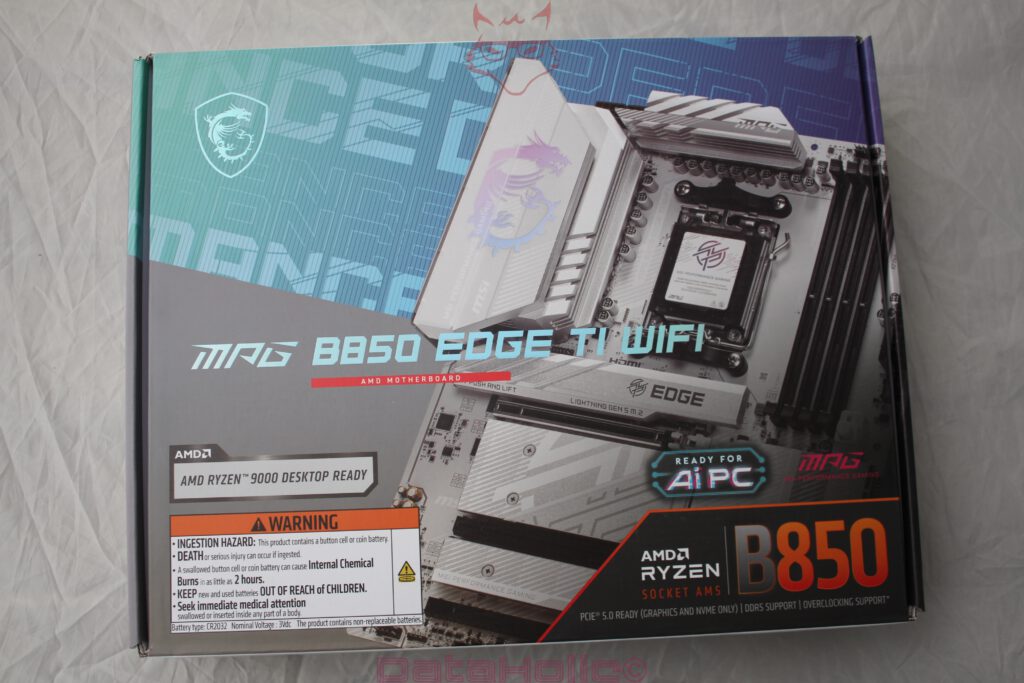
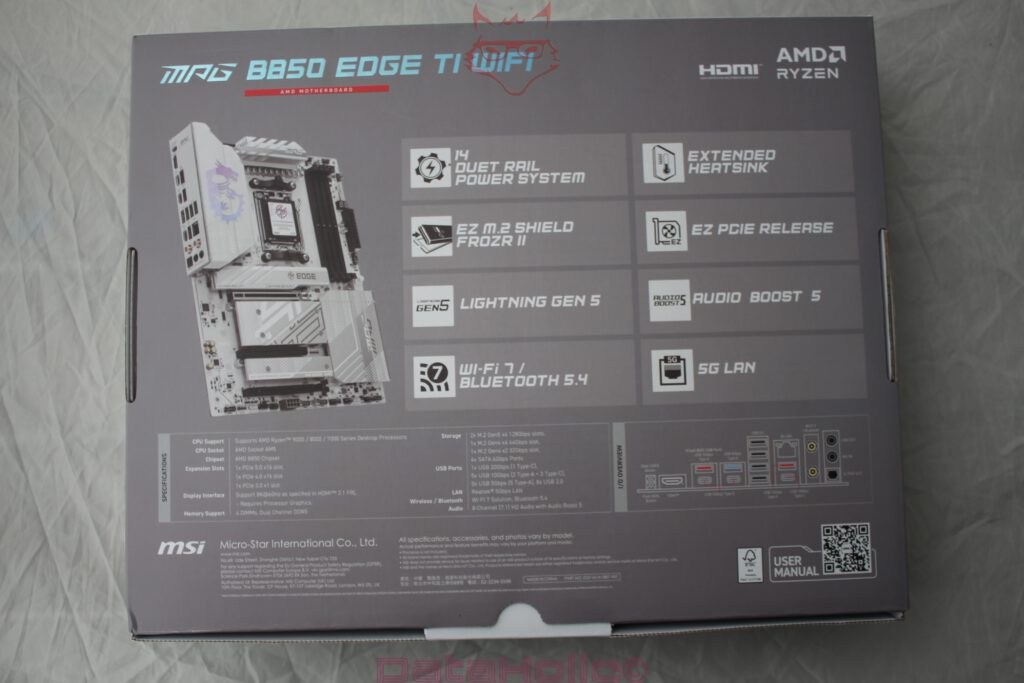
The complete bundle
MSI ships the B850 EDGE Ti WIFI with a respectable accessory set:
- a white-lacquered, magnetic high-gain antenna with a long, fixed cable (for Wi-Fi 7 & BT 5.4),
- two SATA cables (each with one angled connector – handy for tight builds),
- an ARGB adapter and RGB extensions for case lighting,
- front-panel helper parts, EZ-M.2 clips and screws (those small plastic sliders that make M.2 installation screw-free),
- an MSI-style sticker sheet (dragon, logos, “Lucky”),
- Quick Installation Guide and EU Regulatory Notices,
- plus the familiar MSI “Shout Out” card.
A nice touch: the integrated I/O shield – one less part to fumble with and a cleaner look. The white antenna matches the “Edge” aesthetic and looks good whether on a desk or case.
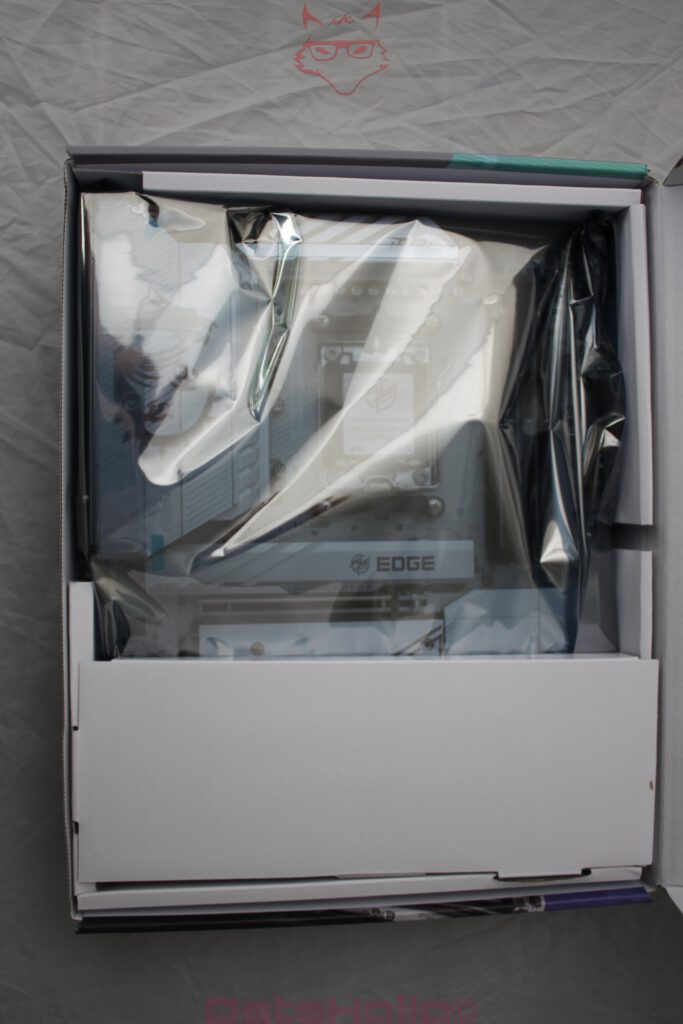
“Form follows function” – and when both are in harmony, a bit of flair does no harm.
Design & Build Quality: White, Angular, Cool
The MPG B850 EDGE Ti WIFI is a white-silver statement piece. While most boards disappear in black, this one demands attention. The large heatsinks over the VRMs and M.2 slots carry etched line patterns and matte surfaces. The MSI dragon logo shines on the left VRM block; the I/O cover and M.2 shields use repeating “Edge” motifs, giving the board depth.
Soldering quality is clean, screws sit flush, and edges are carefully deburred. No flex, no wobble. MSI clearly invests in solid mounting and well-structured functional zones: power delivery up top and left, memory to the right, storage and PCIe at the bottom – right where you’d expect.
Socket, Memory & Slots: The Stage for Ryzen
AM5 at the core
In the center sits the AM5 socket (LGA1718) – the clamp-style design, compatible with most AM4 coolers if the manufacturer provides brackets. A metal-reinforced mounting frame surrounds the socket, giving it rigid strength.
DDR5 setup
To the right: four DDR5 DIMM slots (dual channel), neutral in black. MSI advertises DDR5 overclocking support (exact speeds depending on CPU and firmware – details left for later). More importantly: the 24-pin power connector and USB-C front header sit neatly on the edge, making cable management easy.
PCIe layout
- 1× PCIe 5.0 x16 (CPU direct, reinforced with steel),
- 1× PCIe 4.0 x16 (wired as x4, chipset),
- 1× PCIe 3/4 x1 for small add-ins.
This setup hits the sweet spot: one strong GPU slot, enough lanes for capture, NIC, or storage cards – without the excess of HEDT boards.
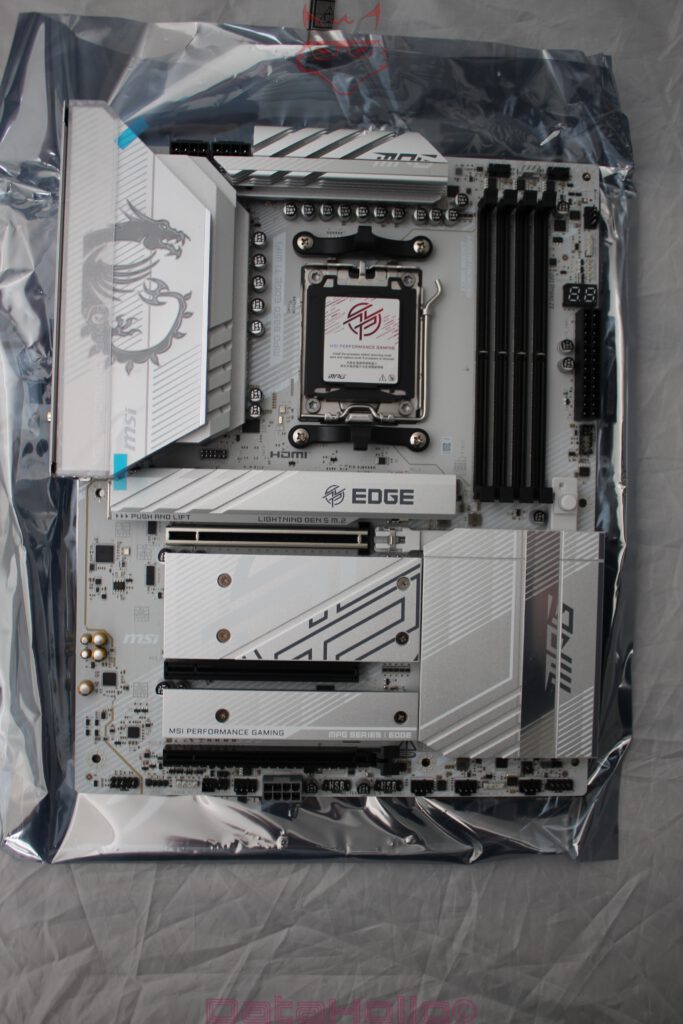
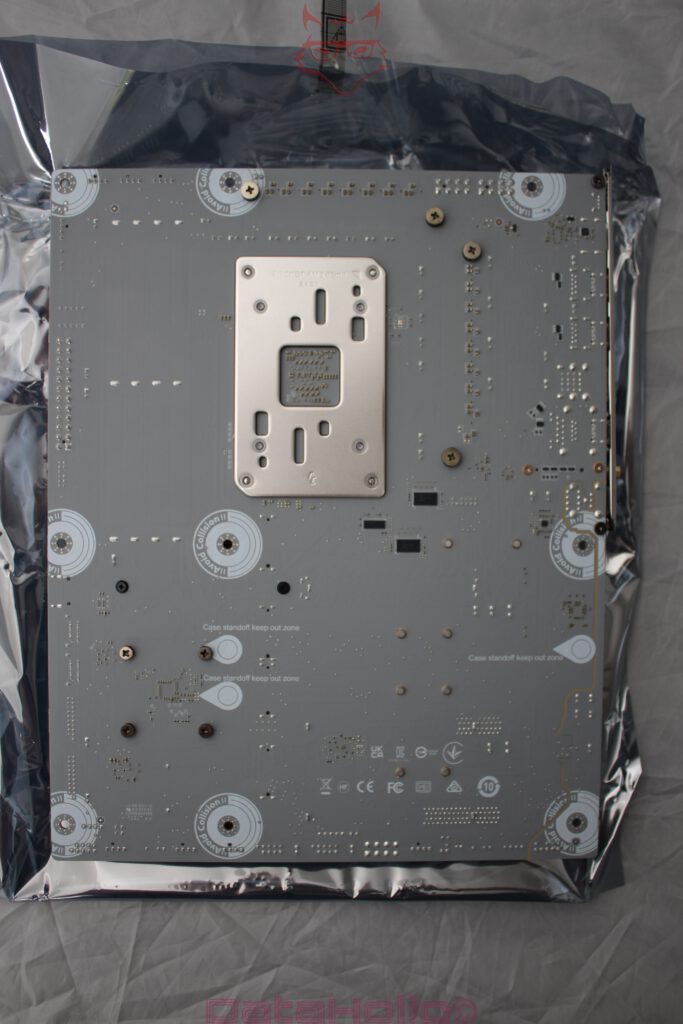
M.2 & SATA: Four NVMe Slots and Legacy Support
The lower half is M.2 territory. Beneath the “Shield Frozr II” heatsinks hide up to four M.2 slots. MSI states two PCIe Gen5 x4 slots (128 Gb/s each) and two Gen4 x4 slots (64 Gb/s each). For a B-series board, this is impressive – matching Ryzen’s push to make fast NVMe the default, not a luxury.
Additionally, there are SATA ports (typically up to six SATA 6 Gb/s), useful for 2.5″ SSDs or 3.5″ HDDs. For anyone with bulk storage or backups, that’s a welcome holdover.
“Nothing is as permanent as a temporary fix” – SATA is proof. Good to see it sticking around.
VRM & Cooling: Headroom for Big Ryzen
The top and left edges are dominated by chunky VRM heatsinks. MSI lists a “14 Duet Rail Power System” – in plain terms: 14 VCore phases, paired in duet rails for better efficiency and heat distribution. In practice: plenty of overhead for everyday and beyond.
The heatsinks are finned, connected by a heatpipe, and sculpted for airflow. The M.2 heatsinks are screwed down, with thermal pads pre-applied neatly.
Bottom line: high-end Ryzen builds will have no trouble with this thermal foundation.
Networking & Audio: Speed by Air and Wire
- Wi-Fi 7 (802.11be) and Bluetooth 5.4: wider channels, lower latency – ideal for VR streaming, fast downloads, or clean cable-free setups. The magnetic antenna works solidly.
- 5G LAN: While 2.5G is the norm, MSI adds a 5G Ethernet port – a solid middle ground toward 10G. Faster than 2.5G, without the high cost of 10G gear.
- Audio Boost 5: isolated circuitry, clean design – sufficient for most headsets and speakers. Audiophiles will, as always, reach for dedicated DAC/amps.
Rear I/O: Well-Laid and Modern
The integrated I/O panel offers a broad USB mix:
- USB-C 20 Gb/s (Gen 2×2),
- several USB-A 10 Gb/s and 5 Gb/s,
- HDMI (for Ryzen iGPU),
- 5G LAN,
- Wi-Fi antenna connectors,
- audio jacks (line out/in, mic, S/PDIF),
- and a Flash BIOS button with dedicated USB port – handy for updating without CPU/RAM/GPU.
Clear labels, generous spacing – ergonomics are solid.
Internal Headers & QoL Features: The Small Things That Matter
For builders, quality-of-life details shine:
- USB-C front header (20 Gb/s),
- two USB 3.2 Gen1 headers,
- multiple USB 2.0 headers (AIO, controllers),
- plenty of PWM fan headers, plus pump headers,
- ARGB and RGB headers top and bottom,
- EZ PCIe Release – a lever to release GPUs without awkward screwdriver work,
- EZ-M.2 clips – no more tiny screws,
- two-digit debug LED, plus boot status LEDs,
- and a clear CMOS header.
For seasoned builders, these are lifesavers. “The devil is in the details” – and here, the devil is tamed.
Board Backside: Clean & Practical
The rear shows clean solder points and “case standoff keep-out zones” printed – helpful during installation. The AM5 backplate is screwed, not glued – important for cooler mounting. Flat finish, no solder blobs – good for tight-fitting cases.
Accessories in Detail: More Than Fillers
The white antenna is both stylish and useful. The magnet base clings firmly, the long cable offers placement flexibility for better signal.
SATA cables are well-made, with angled ends for tricky installs. ARGB/RGB adapters are clearly labeled – invaluable during late-night cable runs.
The sticker sheet offers flair for cases. The Quick Guide is clear with diagrams; a QR code points to BIOS downloads – fast and modern.
First Assembly & Power-On: From Foil to Chassis
The install goes smoothly: the board aligns perfectly with ATX standoffs, the I/O shield fits flush, and screw points are accessible.
AIO tubing routes cleanly past VRM heatsinks, EPS power connectors are reachable, fan headers are placed sensibly.
At first boot, the debug LED shows POST progress, the status LEDs cycle clearly. Lighting is subtle – accent glows behind the dragon logo and heatsinks. In a white-cooled build, the board looks sculptural, almost Nordic.
“Beauty is everywhere a welcome guest,” Goethe once wrote – and hardware is no exception when form and function align.
B850 in Context: The New Mainstream
Without diving into performance yet, B850 clearly positions itself as the new mainstream hub for Ryzen 7000/8000/9000:
- PCIe 5.0 where it counts (GPU + NVMe),
- modern I/O (Wi-Fi 7, BT 5.4, 5G LAN),
- stronger power stages than previous B-series.
The MPG B850 EDGE Ti WIFI is very much the “premium mainstream”: more lanes, more comfort features, a white aesthetic, without X-series pricing. For gamers, creators, and all-round builds – it’s the sweet spot.
Target Groups & Use Cases
- Gamers – with heavy GPUs and fast NVMe drives.
- Content creators – who need fast transfers via USB-C and plenty of storage.
- Enthusiasts – exploring Wi-Fi 7, 5G LAN, or clean white builds.
- Upgraders – coming from AM4, planning for AM5’s future longevity.
Hands-On Notes
- M.2 shields remove smoothly, screws feel precise.
- No sharp edges, safe for cables.
- Silkscreen labels are clear and readable.
- PCIe slot reinforcement is noticeable with heavy GPUs.
- Antenna magnet is strong, doesn’t slip.
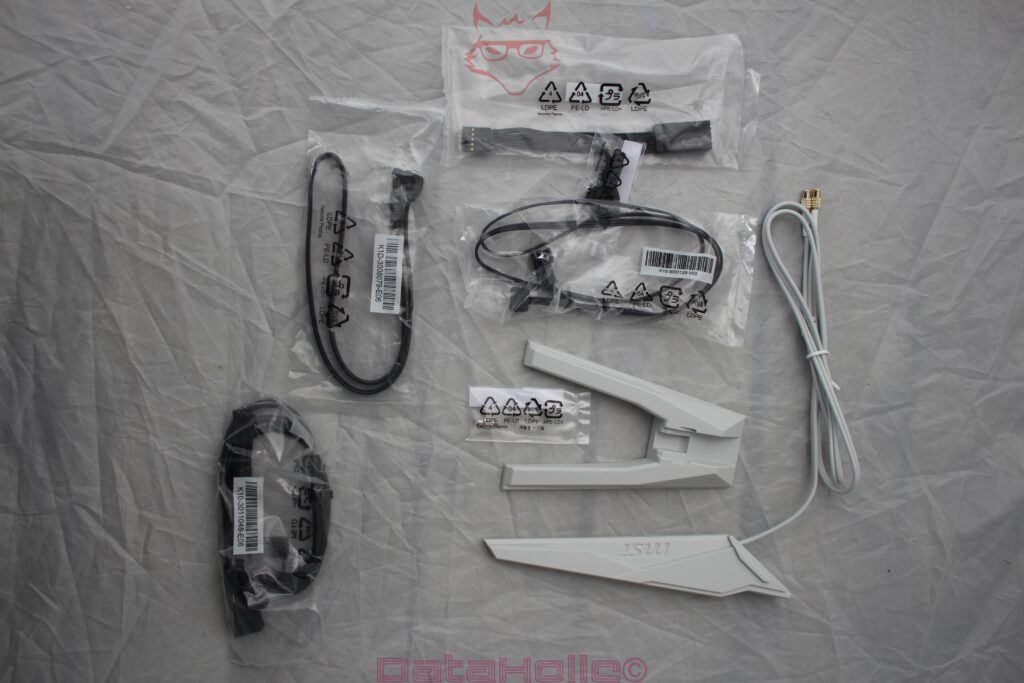
Critical Notes (From an Unboxing POV)
- The white theme requires matching components for visual balance.
- Thermals with four NVMe drives depend on airflow – heatsinks help, but airflow planning is key.
- 5G LAN is great, but requires compatible network gear.
- A front-panel quick connector block would have been the cherry on top.
Minor issues overall – the build quality and design intent shine through.
In-System Impressions: Smooth Build Flow
In a real system with a white AIO and fans, the board looks harmonized and bold. EZ-M.2 clips save time, the PCIe lever is a blessing when swapping GPUs, and the debug display is invaluable for quick troubleshooting.
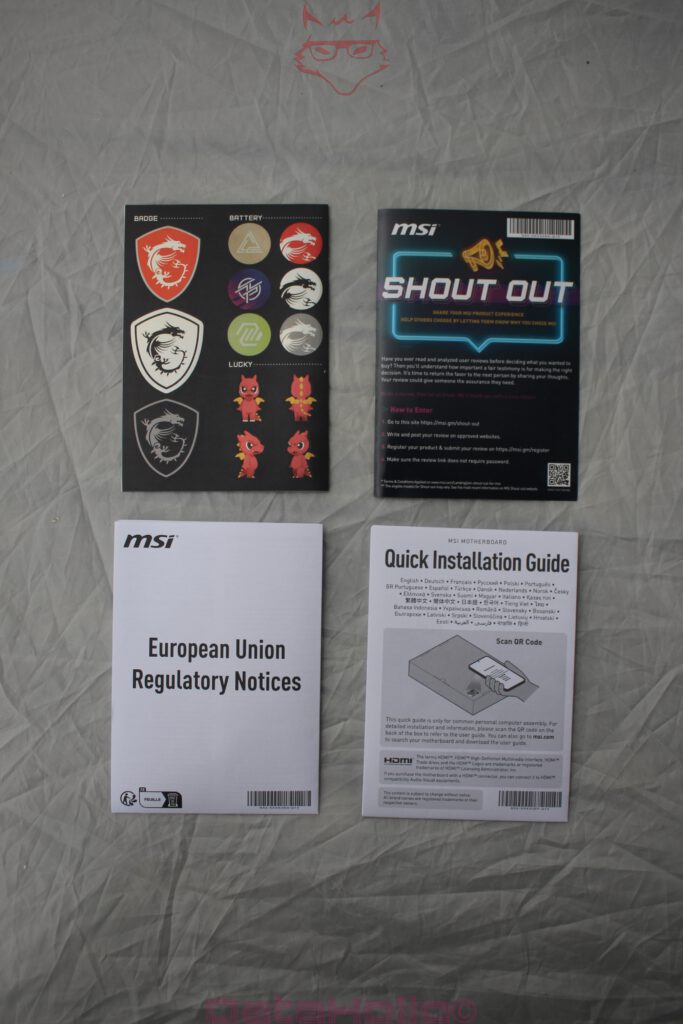
“Simplicity is the ultimate sophistication,” said Leonardo – and here, simple, smart solutions elevate the whole experience.
Mini Interim Conclusion (No Final Verdict Yet)
Unboxing is just the prologue. But some prologues set expectations precisely. The MSI MPG B850 EDGE Ti WIFI promises:
- a modern platform for Ryzen 7000/8000/9000,
- ample PCIe 5.0 where it matters,
- solid VRM foundation,
- future-ready networking,
- builder-friendly features,
- a bright, elegant look that begs for showcase builds.
Further reviews will cover software, BIOS, and benchmarks. Today, it was all about look, feel, and setup – and those first impressions are very strong.
Transparency Note (per EU regulations):
The MSI MPG B850 EDGE Ti WIFI featured in this review was provided to us by MSI as a non-binding loan for testing purposes. This is not paid advertising.
MSI had no influence on the content, evaluation, or editorial independence of this article. All opinions expressed are based solely on our own hands-on experience.
We sincerely thank MSI for providing the motherboard and for their trust in dataholic.de.
